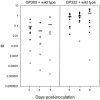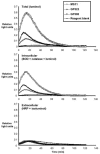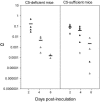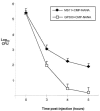Alpha-2,3-sialyltransferase enhances Neisseria gonorrhoeae survival during experimental murine genital tract infection
- PMID: 16790783
- PMCID: PMC1489707
- DOI: 10.1128/IAI.00433-06
Alpha-2,3-sialyltransferase enhances Neisseria gonorrhoeae survival during experimental murine genital tract infection
Abstract
The addition of host-derived sialic acid to Neisseria gonorrhoeae lipooligosaccharide is hypothesized to be an important mechanism by which gonococci evade host innate defenses. This hypothesis is based primarily on in vitro assays of complement-mediated and phagocytic killing. Here we report that a nonpolar alpha-2,3-sialyltransferase (lst) mutant of N. gonorrhoeae was significantly attenuated in its capacity to colonize the lower genital tract of 17-beta estradiol-treated female BALB/c mice during competitive infection with the wild-type strain. Genetic complementation of the lst mutation restored recovery of the mutant to wild-type levels. Studies with B10.D2-HC(o)H2(d)H(2)-T18c/OSN (C5-deficient) mice showed that attenuation of the lst mutant was not due to increased sensitivity to complement-mediated bacteriolysis, a result that is consistent with recently reported host restrictions in the complement cascade. However, Lst-deficient gonococci were killed more rapidly than sialylated wild-type gonococci following intraperitoneal injection into normal mice, which is consistent with sialylation conferring protection against killing by polymorphonuclear leukocytes (PMNs). As reported for human PMNs, sialylated gonococci were more resistant to killing by murine PMNs, and sialylation led to reduced association with and induction of a weaker respiratory burst in PMNs from estradiol-treated mice. In summary, these studies suggest sialylation confers a survival advantage to N. gonorrhoeae in mice by increasing resistance to PMN killing. This report is the first direct demonstration that alpha-2,3-sialyltransferase contributes to N. gonorrhoeae pathogenesis in an in vivo model. This study also validates the use of experimental murine infection to study certain aspects of gonococcal pathogenesis.
Figures







Similar articles
-
α-2,3-sialyltransferase expression level impacts the kinetics of lipooligosaccharide sialylation, complement resistance, and the ability of Neisseria gonorrhoeae to colonize the murine genital tract.mBio. 2015 Feb 3;6(1):e02465-14. doi: 10.1128/mBio.02465-14. mBio. 2015. PMID: 25650401 Free PMC article.
-
Neisseria gonorrhoeae catalase is not required for experimental genital tract infection despite the induction of a localized neutrophil response.Infect Immun. 2007 May;75(5):2225-33. doi: 10.1128/IAI.01513-06. Epub 2007 Feb 12. Infect Immun. 2007. PMID: 17296753 Free PMC article.
-
The Lst Sialyltransferase of Neisseria gonorrhoeae Can Transfer Keto-Deoxyoctanoate as the Terminal Sugar of Lipooligosaccharide: a Glyco-Achilles Heel That Provides a New Strategy for Vaccines to Prevent Gonorrhea.mBio. 2021 Mar 23;12(2):e03666-20. doi: 10.1128/mBio.03666-20. mBio. 2021. PMID: 33758087 Free PMC article.
-
Species-specificity of Neisseria gonorrhoeae infection: do human complement regulators contribute?Vaccine. 2008 Dec 30;26 Suppl 8:I62-6. doi: 10.1016/j.vaccine.2008.11.051. Vaccine. 2008. PMID: 19388167 Review.
-
Defenses against oxidative stress in Neisseria gonorrhoeae: a system tailored for a challenging environment.Microbiol Mol Biol Rev. 2006 Jun;70(2):344-61. doi: 10.1128/MMBR.00044-05. Microbiol Mol Biol Rev. 2006. PMID: 16760307 Free PMC article. Review.
Cited by
-
Phase-Variable Heptose I Glycan Extensions Modulate Efficacy of 2C7 Vaccine Antibody Directed against Neisseria gonorrhoeae Lipooligosaccharide.J Immunol. 2016 Jun 1;196(11):4576-86. doi: 10.4049/jimmunol.1600374. Epub 2016 May 2. J Immunol. 2016. PMID: 27183633 Free PMC article.
-
Utilizing complement evasion strategies to design complement-based antibacterial immunotherapeutics: Lessons from the pathogenic Neisseriae.Immunobiology. 2016 Oct;221(10):1110-23. doi: 10.1016/j.imbio.2016.05.016. Epub 2016 Jun 1. Immunobiology. 2016. PMID: 27297292 Free PMC article. Review.
-
A strain-specific catalase mutation and mutation of the metal-binding transporter gene mntC attenuate Neisseria gonorrhoeae in vivo but not by increasing susceptibility to oxidative killing by phagocytes.Infect Immun. 2009 Mar;77(3):1091-102. doi: 10.1128/IAI.00825-08. Epub 2008 Dec 29. Infect Immun. 2009. PMID: 19114548 Free PMC article.
-
Opacity proteins increase Neisseria gonorrhoeae fitness in the female genital tract due to a factor under ovarian control.Infect Immun. 2010 Apr;78(4):1629-41. doi: 10.1128/IAI.00996-09. Epub 2010 Jan 25. Infect Immun. 2010. PMID: 20100859 Free PMC article.
-
Neisseria gonorrhoeae scavenges host sialic acid for Siglec-mediated, complement-independent suppression of neutrophil activation.bioRxiv [Preprint]. 2024 Jan 18:2024.01.17.576097. doi: 10.1101/2024.01.17.576097. bioRxiv. 2024. Update in: mBio. 2024 May 8;15(5):e0011924. doi: 10.1128/mbio.00119-24. PMID: 38293026 Free PMC article. Updated. Preprint.
References
-
- Apicella, M. A., R. E. Mandrell, M. Shero, M. E. Wilson, J. M. Griffiss, G. F. Brooks, C. Lammel, J. F. Breen, and P. A. Rice. 1990. Modification by sialic acid of Neisseria gonorrhoeae lipooligosaccharide epitope expression in human urethral exudates: an immunoelectron microscopic analysis. J. Infect. Dis. 162:506-512. - PubMed
-
- Belland, R. J., T. Chen, J. Swanson, and S. H. Fischer. 1992. Human neutrophil response to recombinant neisserial Opa proteins. Mol. Microbiol. 6:1729-1737. - PubMed
-
- Beuzon, C., and D. Holden. 2001. Use of mixed infections with Salmonella strains to study virulence genes and their interactions in vivo. Microbes Infect. 3:1345-1352. - PubMed
-
- Bouchet, V., D. W. Hood, J. Li, J. R. Brisson, G. A. Randle, A. Martin, Z. Li, R. Goldstein, E. K. Schweda, S. I. Pelton, J. C. Richards, and E. R. Moxon. 2003. Host-derived sialic acid is incorporated into Haemophilus influenzae lipopolysaccharide and is a major virulence factor in experimental otitis media. Proc. Natl. Acad. Sci. USA 100:8898-8903. - PMC - PubMed
Publication types
MeSH terms
Substances
Grants and funding
LinkOut - more resources
Full Text Sources
Other Literature Sources
Research Materials
Miscellaneous

